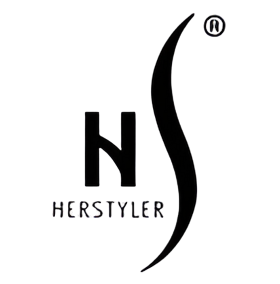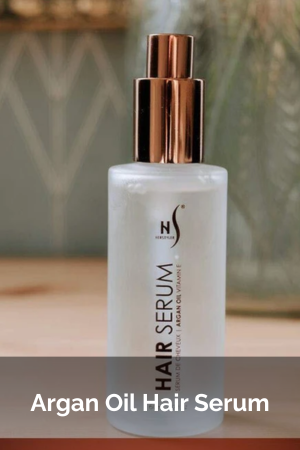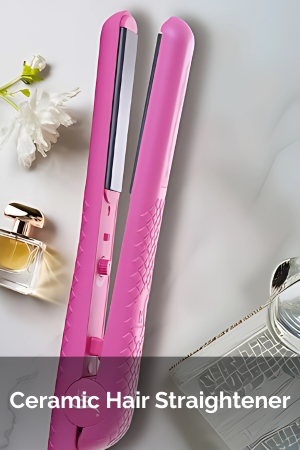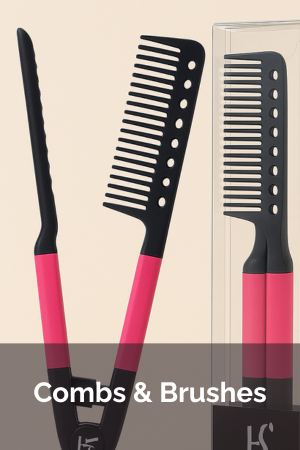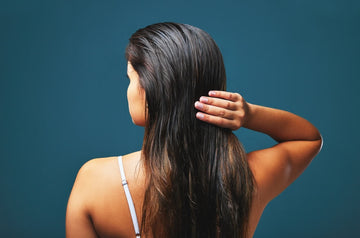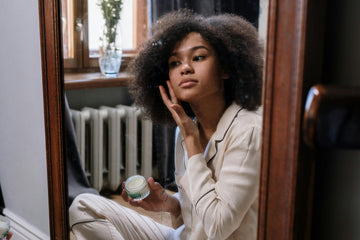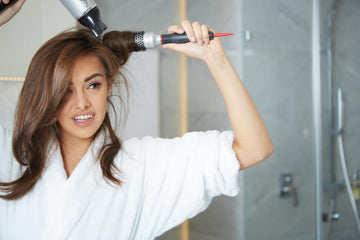Greasy hair can be extremely frustrating to deal with. Even if you manage to wash and style it in a way that gets rid of that oily sheen, it can sometimes be only a matter of hours before your hair starts to look limp and overly shiny once again.
So, what’s the solution? Is it possible to banish your hair’s greasy appearance for good? The answer is yes, but you’ll need to take a multi-pronged approach. Read on as HerStyler talks you through how to do this!
Why Do You Have Greasy Hair in the First Place?
Before we get started, it’s important to understand why your hair is so greasy in the first place…
It all comes down to the sebum produced by your scalp. Everyone’s scalp produces these oils, with this sebum being vital for keeping hair moisturized and protected.
However, some people produce more sebum than others. Why? There are a few reasons behind the overproduction of sebum, with the most common being:
- Genetics – not only do your genes determine how much sebum your scalp produces, but they’re also responsible for your hair type. If your hair happens to be quite fine and thin, it will look limper and greasier faster than hair that’s thick or coarse.
- Environment – warm weather and high humidity increase sebum production. This, combined with the extra sweating that you do in these conditions, can quickly cause greasy hair.
- Hormonal fluctuations – your hormones directly impact how much sebum your scalp/skin produces. Therefore, any changes in your hormone levels, whether this may be from puberty, pregnancy, menopause, or stress, can leave your hair feeling extra oily.
- Lifestyle – everything from your diet to your hairstyling routine can affect how much oil your scalp produces.
Now that you know some of the possible causes behind your greasy hair, let’s talk about what you can do to make your hair look and feel less oily…
Reassess How Often You Wash Your Hair
Sometimes, not washing your locks often enough can be the reason behind greasy hair. It causes a buildup of sebum on your scalp and strands, which weighs the hair down and leaves it looking oily.
This is why people who are prone to greasy hair tend to have a strict hair-washing schedule. However, washing your hair too often isn’t advisable either. Sure, a good shampoo session may clear away all of that excess sebum, but, as we mentioned, sebum serves a purpose. If your scalp feels as though it’s lacking in sebum due to how often those oils are washed away, it will ramp up its sebum production, leaving your hair even oilier in between washes.
If you wash your hair daily, try switching to every other day. Likewise, if you already wash your hair every other day, leave an extra day between washes. Be patient as it will take some time for your scalp to rebalance its sebum production but, once it does, you may find that cutting back on how often you wash your locks is a surprising solution to your greasy hair.
Be Clever When Shampooing
 When it comes to washing your hair, how often you wash it isn’t the only factor to pay attention to. The technique that you use, along with your shampoo formula, will make a huge difference to how oily your hair feels too.
When it comes to washing your hair, how often you wash it isn’t the only factor to pay attention to. The technique that you use, along with your shampoo formula, will make a huge difference to how oily your hair feels too.
To start with, pick a formula that’s suitable for greasy hair. This means avoiding any products that have been designed specifically for dry or damaged hair. Those formulas will usually contain rich oils that, while helpful for repairing the look of damage, will only weigh already-greasy hair down.
Instead, look for a lightweight shampoo, such as the Sleek Hair Shampoo in our Essential Hair Care Set. It will clear away excess sebum, dirt, and other impurities while leaving your hair feeling stronger and more resilient.
When using this, or any, shampoo, use your fingertips to gently work it into your scalp. Don’t be tempted to harshly scrub or scratch at your head with your fingernails. Friction on your scalp could trigger it to produce more sebum, so keep your touch light.
Be Careful When Conditioning
 It’s so important to use a conditioner after washing your hair. This is the best way to restore the moisture that your shampoo has removed.
It’s so important to use a conditioner after washing your hair. This is the best way to restore the moisture that your shampoo has removed.
However, when applying your conditioner, keep it well away from your scalp. As you know, your scalp is already producing plenty of its own oils. It doesn’t need the extra help that a conditioner provides. While those with dry hair sometimes apply a conditioner to their mid-lengths and work their way down, keep your conditioner focused on the very ends of your hair. If your conditioner ends up on or near your scalp, it will only mix in with the excess sebum that’s already being produced in this area. This will leave your hair looking even greasier.
Picking the right conditioner is vital too. You don’t need an overly rich formula – a lightweight blend, such as the HerStyler Rosehip & Sage Conditioner, would be more suitable. This product contains a number of hydrating ingredients that won’t weigh your strands down. It’s a great way to condition greasy hair without exacerbating its oiliness.
Be Gentle With Your Blow Dryer
 A blow dryer can be a very useful tool when dealing with greasy hair. Using one, instead of allowing your hair to air dry, can help to reduce the amount of sebum that’s lingering on your scalp.
A blow dryer can be a very useful tool when dealing with greasy hair. Using one, instead of allowing your hair to air dry, can help to reduce the amount of sebum that’s lingering on your scalp.
However, at the same time, too much heat can irritate your scalp, causing it to produce more oil.
The solution is to find yourself a powerful blow dryer with an adjustable temperature control, like the HerStyler LED Pro Luxe Dryer. This blow dryer is fitted with an 1800-watt motor. This means that it emits a strong blast of hair, which will dry your hair faster than lower-wattage models, even when a lower heat setting is used. The fact that this blow dryer also comes with red LED technology is a big bonus. This can help to reduce how oily your hair feels while also leaving your hair looking thicker and fuller.
Regularly Clean Your Hairbrush and Styling Tools
 Each time your hairbrush touches your hair, it picks up traces of oil, along with product residue, dead skin cells, and other impurities. The next time you use that hairbrush, the oil that it’s harboring, along with the other impurities, will transfer back onto your locks.
Each time your hairbrush touches your hair, it picks up traces of oil, along with product residue, dead skin cells, and other impurities. The next time you use that hairbrush, the oil that it’s harboring, along with the other impurities, will transfer back onto your locks.
This is why using a dirty hairbrush is a big no-no, especially if you’re already struggling with greasy hair. It will only make your hair feel oilier and dirtier. Chances are that you’ll then end up washing your hair sooner than you would have otherwise needed to, which, as you now know, can cause an increase in sebum production.
While general recommendations are to wash your hairbrush every week or so, you may want to do this a little more often if your hair is naturally greasy. The cleaner you keep your hairbrush, the cleaner and less oily your hair will be.
Of course, this applies to any other styling tools that you use too. From flat irons to curling wands, keep all of your tools clean to ensure that you’re not contaminating your hair each time you use them.
Stop Touching Your Hair and Scalp
If you often run your hands through your hair or twirl your strands around your fingers, it’s time to break this habit.
Why? For two reasons. Firstly, as we mentioned earlier, friction or pressure on your scalp will stimulate it into producing more sebum, which you definitely don’t need.
Secondly, each time you touch your hair, you’re likely doing so with unclean hands. Just like the rest of your skin, the surface of your hands is covered with sebum of its own, plus dirt and other impurities. Touch your hair and all of this will transfer onto your strands, leaving them feeling heavier and greasier.
Keep Your Hair Away From Your Face and Neck
Of course, even if you don’t regularly touch your hair, it can still end up covered in excess sebum due to the contact that it has with your skin. This is extremely common when hair is left loose. It spends the day touching your neck and your face, with sebum transferring back and forth.
With that said, you don’t want to go to the other extreme and constantly have your hair tied back either. After all, this involves running your hands or your hairbrush through your locks, which will only spread the sebum from your scalp to the rest of your strands.
Find a middle ground where you sometimes tie your hair back into a loose bun or ponytail but leave it loose at other times. If you’ve just washed your hair, try leaving it loose, but then go ahead and tie it back when you plan on washing it the next day.
Cut Back on Your Consumption of Sugar and Refined Carbs
You’re probably aware of how your diet can impact your skin. Consuming overly processed foods that are high in sugars and refined carbohydrates can cause the skin to produce more oil. This is why people who eat large amounts of those foods are often prone to acne.
What does this have to do with greasy hair? Well, your scalp is made up of skin. This means that those same foods that affect your face will also influence the sebum produced by your scalp. If your meals are filled with white breads, white rice, white pastas, and sugars, your scalp will respond by producing more oil.
Cut back on these foods and you should notice the opposite effect. Take things further by eating more leafy greens, fresh fruits, fermented foods, and lean proteins – these will all help to lower sebaceous activity, which should leave your hair feeling less oily in the long run.
Summary
Some people are under the impression that if they have greasy hair, then they’re stuck with this for life. Fortunately, that’s not the case. Even if your overly oily strands are down to genetics, there are still plenty of steps that you can take to reduce how greasy your scalp and strands feel. Keep our advice in mind and your hair will soon look healthier while becoming so much easier to manage!
Click here to shop for more bestselling hair products from HerStyler.

